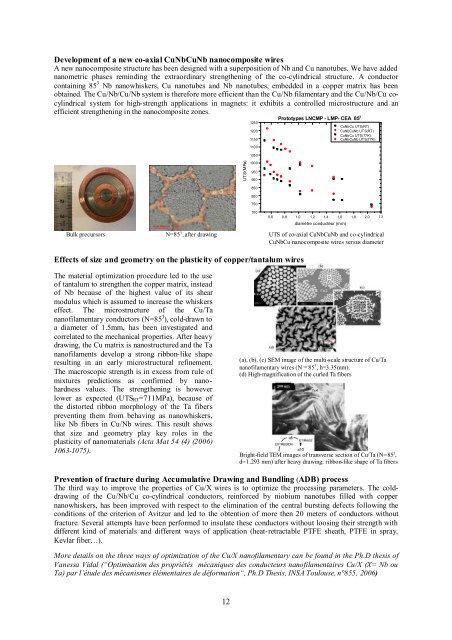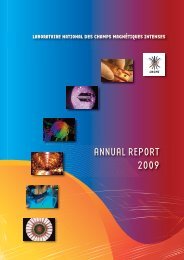Laboratoire National des Champs Magnétiques Pulsés CNRS – INSA
Laboratoire National des Champs Magnétiques Pulsés CNRS – INSA
Laboratoire National des Champs Magnétiques Pulsés CNRS – INSA
Create successful ePaper yourself
Turn your PDF publications into a flip-book with our unique Google optimized e-Paper software.
Development of a new co-axial CuNbCuNb nanocomposite wires<br />
A new nanocomposite structure has been <strong>des</strong>igned with a superposition of Nb and Cu nanotubes. We have added<br />
nanometric phases reminding the extraordinary strengthening of the co-cylindrical structure. A conductor<br />
containing 85 3 Nb nanowhiskers, Cu nanotubes and Nb nanotubes, embedded in a copper matrix has been<br />
obtained. The Cu/Nb/Cu/Nb system is therefore more efficient than the Cu/Nb filamentary and the Cu/Nb/Cu cocylindrical<br />
system for high-strength applications in magnets: it exhibits a controlled microstructure and an<br />
efficient strengthening in the nanocomposite zones.<br />
12<br />
UTS(MPa)<br />
1250<br />
1200<br />
1150<br />
1100<br />
1050<br />
1000<br />
950<br />
900<br />
850<br />
800<br />
750<br />
700<br />
Prototypes LNCMP - LMP- CEA 85 3<br />
CuNbCu UTS(RT)<br />
CuNbCuNb UTS(RT)<br />
CuNbCu UTS(77K)<br />
CuNbCuNb UTS(77K)<br />
0,6 0,8 1,0 1,2 1,4 1,6 1,8 2,0 2,2<br />
diamètre conducteur (mm)<br />
Bulk precursors N=85 3 ,after drawing UTS of co-axial CuNbCuNb and co-cylindrical<br />
CuNbCu nanocomposite wires versus diameter<br />
Effects of size and geometry on the plasticity of copper/tantalum wires<br />
The material optimization procedure led to the use<br />
of tantalum to strengthen the copper matrix, instead<br />
of Nb because of the highest value of its shear<br />
modulus which is assumed to increase the whiskers<br />
effect. The microstructure of the Cu/Ta<br />
nanofilamentary conductors (N=85 3 ), cold-drawn to<br />
a diameter of 1.5mm, has been investigated and<br />
correlated to the mechanical properties. After heavy<br />
drawing, the Cu matrix is nanostructured and the Ta<br />
nanofilaments develop a strong ribbon-like shape<br />
resulting in an early microstructural refinement.<br />
The macroscopic strength is in excess from rule of<br />
mixtures predictions as confirmed by nanohardness<br />
values. The strengthening is however<br />
lower as expected (UTSRT=711MPa), because of<br />
the distorted ribbon morphology of the Ta fibers<br />
preventing them from behaving as nanowhiskers,<br />
like Nb fibers in Cu/Nb wires. This result shows<br />
that size and geometry play key roles in the<br />
plasticity of nanomaterials (Acta Mat 54 (4) (2006)<br />
1063-1075).<br />
(a), (b), (c) SEM image of the multi-scale structure of Cu/Ta<br />
nanofilamentary wires (N = 85 3 , h=3.35mm).<br />
(d) High-magnification of the curled Ta fibers<br />
Bright-field TEM images of transverse section of Cu/Ta (N=85 3 ,<br />
d=1.293 mm) after heavy drawing: ribbon-like shape of Ta fibers<br />
Prevention of fracture during Accumulative Drawing and Bundling (ADB) process<br />
The third way to improve the properties of Cu/X wires is to optimize the processing parameters. The colddrawing<br />
of the Cu/Nb/Cu co-cylindrical conductors, reinforced by niobium nanotubes filled with copper<br />
nanowhiskers, has been improved with respect to the elimination of the central bursting defects following the<br />
conditions of the criterion of Avitzur and led to the obtention of more then 20 meters of conductors without<br />
fracture. Several attempts have been performed to insulate these conductors without loosing their strength with<br />
different kind of materials and different ways of application (heat-retractable PTFE sheath, PTFE in spray,<br />
Kevlar fiber…).<br />
More details on the three ways of optimization of the Cu/X nanofilamentary can be found in the Ph.D thesis of<br />
Vanessa Vidal (“Optimisation <strong>des</strong> propriétés mécaniques <strong>des</strong> conducteurs nanofilamentaires Cu/X (X= Nb ou<br />
Ta) par l’étude <strong>des</strong> mécanismes élémentaires de déformation“, Ph.D Thesis, <strong>INSA</strong> Toulouse, n°855, 2006)







